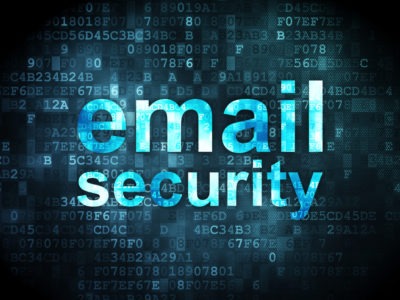 Cybercriminals continue to advance each year as companies try to anticipate the best ways to protect themselves from the latest data breach tactics. Although sophisticated hacking stories often dominate the headlines, sometimes the most vulnerable points in a company can be found in the least dramatic places. Email has been an effective way for hackers to get access to sensitive information since it was first introduced. However, it can be easily overlooked since it’s such a common communication tool and assumed that all users are using best practices to keep their accounts safe.
Cybercriminals continue to advance each year as companies try to anticipate the best ways to protect themselves from the latest data breach tactics. Although sophisticated hacking stories often dominate the headlines, sometimes the most vulnerable points in a company can be found in the least dramatic places. Email has been an effective way for hackers to get access to sensitive information since it was first introduced. However, it can be easily overlooked since it’s such a common communication tool and assumed that all users are using best practices to keep their accounts safe.
Fortunately, implementing email security best practices is a relatively simple measure that can be added to your cybersecurity plan to help keep your sensitive data protected from cyberattacks.
Common Email Security Threats
Email security can be as complex or simple as your company needs. To be effective, it should at least address the most common points of attack. Here are some of the most frequent tactics used by scammers and hackers.
- Malware: Malicious software that can be uploaded to a single device or company network through email attachments. The software can be used to steal sensitive information, such as passwords and Social Security numbers, to be used to identify theft and other crimes. Ransomware is the latest version of malware to hit the headlines, where software encrypts a company’s files, withholding the decryption key until the company pays a specified amount of money as ransom.
- Phishing: Also called spoofing, phishing attacks involve emails designed to look as though they’ve been sent from a trusted source. These emails will often ask for the recipient to log in or verify sensitive information with the claim that their account with the trusted company has been compromised. When the user fills in the requested information, it’s routed to the source of the impostor email.
- Spam: Unsolicited bulk emails. Spamming is often used in phishing attacks or to send out malware. While this used to involve the end users actively downloading an attachment or supplying information, spam techniques have become more sophisticated, and it’s possible to be infected with malware simply by opening the spam email.
- Human malice/mistakes: Insider attacks are more common than some might think and are an important consideration. Disgruntled employees can use their credentials to create issues on their own or possibly seek outside help. Sometimes the threat is unintentional, such as the use of weak passwords, leaving devices unattended and unlocked or sharing log-in information.
Remember that any of these threats can be used in conjunction with another, and today’s cybercriminals often employ more than one tactic to increase the chances their attempts are successful.
Email Security Solutions
Fortunately, there are several steps a company can take to protect itself from data breaches through email communications. Some require the application of special tools, while others are simply a shift in the company’s network IT security policies and better training for employees. Here are the steps you can take to help protect your business from email security threats:
- Check your email service configurations. Misconfigurations can allow outside sources access to send emails from within. If you’re using a third-party email service, make sure to employ any updates that are released to ensure you’re using the most secure version. If your company hosts its own email server, make sure your IT experts check it for potential weaknesses. If you don’t have an IT expert, there are affordable outsourcing options that can help. Remember simple configurations are less likely to have issues, so it’s a good idea to stay away from overly complex mail routing.
- Use filters and software to your advantage. Choose a strong anti-virus and anti-malware software. There are hundreds of options to help identify and isolate any malicious software that makes it past your security measures. Many of them can identify suspicious downloads before they get access. Choose the solutions that work best for your situation, and make sure you keep them updated so you have protection from the latest threats. Spam filters are another great way to help prevent business email compromise.
- Opt for two-factor authentication. Users who wish to gain access to your email servers or service are required to share something they know, such as a password, along with something they have, such as a mobile device. Once the user logs in with the correct password, a code or link is sent to another device specific to the individual to confirm the correct person is logging in. This method will also prevent simultaneous log-ins from the same account. When an employee is let go, make sure to remove their authentication to prevent later access.
- Maintain regular security awareness training. Make sure your staff understands password security, the importance of logging off when away from their device, how to spot phishing emails and why they should never download an attachment from a source that isn’t trusted. Teach them what to do if they identify a scam attempt, have a system in place to require strong passwords and encourage them to keep their inboxes clean to more easily spot spammers. It’s also a good idea to require new and unique passwords after a set amount of time just in case one has been compromised.
- Make sure your emails are encrypted. If hackers manage to gain access to emails being sent, encryption will prevent all but the most dedicated from obtaining any potentially sensitive information from them. Your email service should have instructions for email encryption, or you can seek outside help if you host in-house.
- Have a robust response action plan in place in the event of a security breach. If hackers gain access to an email account, the goal becomes widening access within the network. If you’re able to spot the breach quickly and have a security strategy prepared, you can greatly minimize the impact. Depending on their position in the company, make sure every user with access knows what to look for to identify potential breaches and what action they should take to put the plan into action.
About the Author: EIRE Systems
EIRE Systems is a leading independent provider of professional IT, AV and Access Security services to the financial, insurance, manufacturing, health care, retail, construction, hospitality, commercial real estate, legal, educational and multinational sectors in Japan and throughout the Asia Pacific region. EIRE Systems has expertise across a wide spectrum of Information Technologies, with a track record for successfully completing hundreds of assignments since its establishment in 1996.



